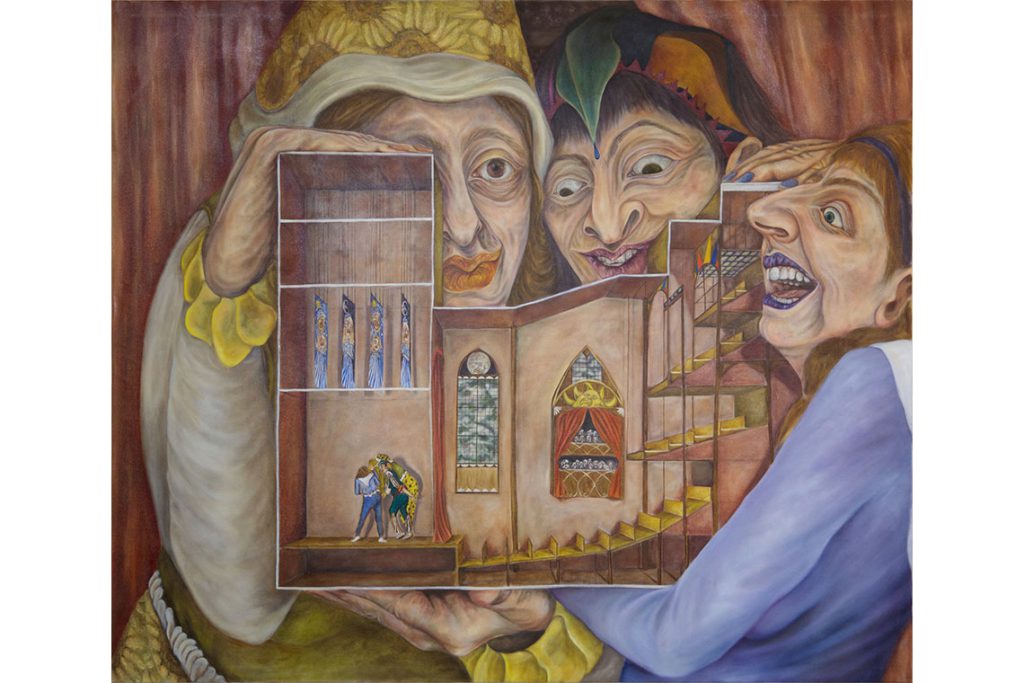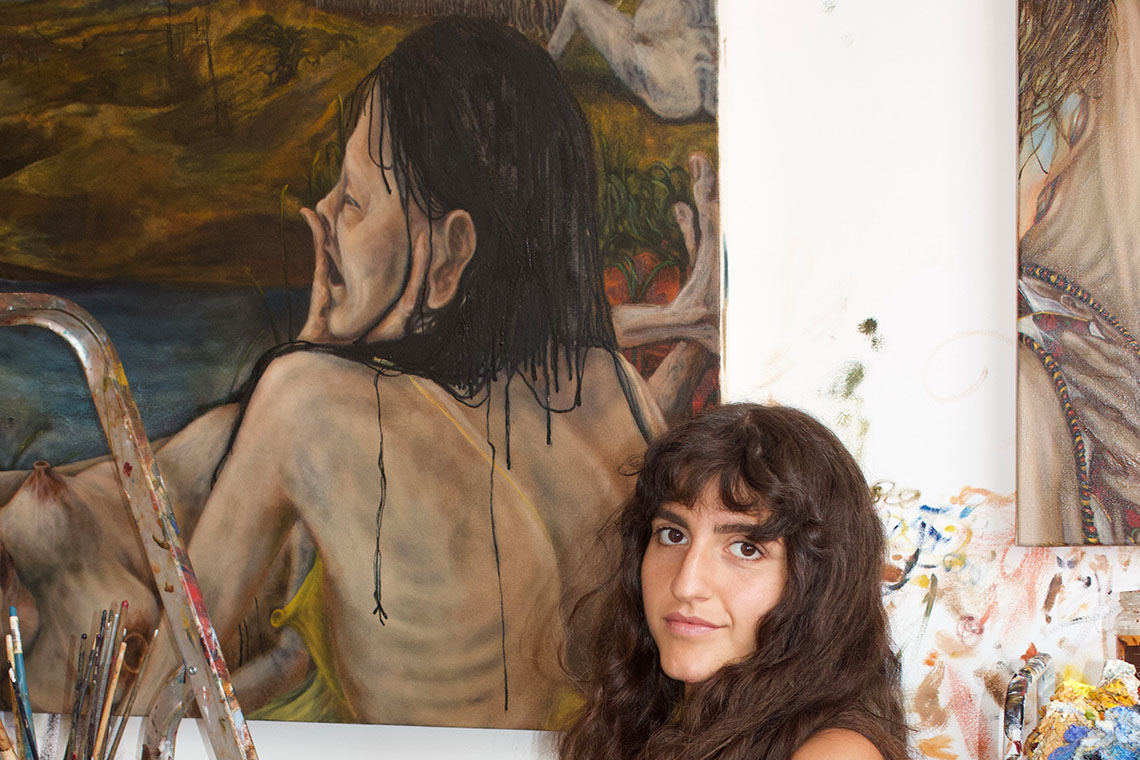The London-based artist discusses wrinkles and ripples as the creatures in her work highlight complex relationships in imagined worlds.
Canvas: Figures feature prominently in your work. Where do they come from? What are their relationships to each other?
Nour El Saleh: My practice stems from my imagination, it’s unplanned. The process of making a work is a discovery in terms of what the figure will be, how the combination of figures will unfold, where they are, who they are and the overall context of the work. When I’m building these fictionalised ecosystems, I see the figures as vessels that carry meanings or are in pursuit of specific answers. Their physical features come from my mind, my own features and those of people around me. They’re the first thing my imagination can capture, but they lack any specific identity. Although they’re meant to be relatable, you can’t tell exactly who they are. The way they relate to each other is another aspect to my work. There are questions around whether they are caring for each other or feeding off one another. What might look like someone holding something might instead be them choking it instead.
Some of your work incorporates theatrical settings and stages. What draws you to that particular aesthetic?
I studied drama at school when a teenager. It was the earliest experience I had in terms of understanding art and creativity within the scope of theatre, as opposed to a two-dimensional plane, so those rules of composition still stand out in my mind. When I’m creating figures, none will ever have their back completely turned, just as you would see on stage. Theatre also felt like the most accessible way to deal with a world that has no specific meaning. If I were to start a painting and dress the figures in particular clothing, I create a setting that is mimicking something that already exists. It almost says too much. So I started to think about the theatre and what if skin was a costume or an outfit? It expands the possibilities of where things can go without having to pinpoint what the setting is.

Why is it important that these ecosystems don’t indicate a specific place or time?
It’s important that the work I’m making does not feel stuck and that it is a moment that I can continue building on. I am from somewhere; I grew up somewhere else and then moved to London when I was 17. I’ve always been surrounded by people from everywhere and a sense of a specific culture or place doesn’t feel solid in my mind. Equally, it doesn’t feel like a problem that I’m trying to tackle through my work. It allows me the freedom to explore anything and anywhere. The worlds I create are a combination of all the places I’ve been to and all the places I dream of. When I put them together, they become another place that I’ve never seen.
Considering the idea of skin as a costume, what role do the exaggerated features play?
On the technical side, I love painting wrinkles. Even if it’s the sky, you can see a similar language with the rippling aesthetic. These disturbing textures also come from the way paint sets, qualities that also feed into these bodies because they start looking really old, dehydrated and exaggerated. With these bodies I can create anything, I’m not harming anything or anyone, so the extremities to which I can take a body in a painting are so different from what you could do with a real body. There is also the element of exploring ugliness and beauty, not specifically through societal norms but by creating these space-filling creatures that often have really long hands and big noses. It’s not so conscious, but it challenges my understanding of what’s around me.
Some of your work incorporates 3D or sculptural aspects. How did these elements emerge?
I think about painting in a very sculptural way. I think of the way the light hits the surface, the wrinkles and ripples. When I started playing with clay, I became obsessed with it and putting it together with painting. Some of my miniatures have sculptures actually growing out of them.
How do you select the colour palette for these imagined ecosystems?
I’ve got to the point now where I know there’s around five paints that I have to constantly have in my studio. They’re usually a combination that make up a kind of olive-skin colour. For landscapes, I continue to play with them depending on what’s happening around me. I am very affected by my surroundings and weather. Last summer I was painting in the south of Italy and suddenly everything had a yellow light and felt really warm after a few years of living in London, when they had become colder and greyer.

What role do animals play in your work?
They come in and out in different ways. The rats specifically became really important. I have a writing practice adjacent to my work, but that’s only for me and not something I share at all. Usually when something is featured in my writing it doesn’t make it into my paintings because it feels as if that is my thing. However, I had written a letter to a rat because I would often encounter them in the London Underground and rat skin is very much up my alley in terms of painting, it’s gross and rippled. It felt like an important milestone to break that barrier and incorporate these animals into my paintings, but these rats are never rats – they’re always humanoid rats. The addition of these creatures also became a way to incorporate other things I wanted to bring in, such as insects. These are now prominent in my work, not a specific insect but you’ll see a figure with long limbs like a spider or the construction of a face.
Does the physique of the creatures relate to their characters?
I used to be very interested in the study of physiognomy and aspects taken from different animals to portray personality traits, so if you see someone that looks ratty in the painting, you may think that they’re a villain. It’s very similar to my relationship with size. A lot of the time the tiny creatures are the most important, as well as being the most calculating as well – they know exactly what’s going on. You can tell that they’re manipulating the whole thing. The big figures are quite passive, as if they’re just kind of going through whatever it is. It’s a switch from what you would think, because a giant or anything big usually insinuates power.
What’s next up for you?
At the moment, I’m focusing my practice on more group shows and collaborative projects. There are three group shows coming up. Half Truths – Half 1 (opens 22 September) and Half 2 (opens 11 October) by DATEAGLE and is co-produced by Vanessa Murrel, Hector Rosenfalck and Henry Dennler. Two more group shows will also open in December. I’m really excited about these exhibitions as they all revolve around the realm of fictionalisation and it’ll be great to work with other people and see how they all merge together.
This interview first appeared in Canvas 109: Smoke and Mirrors



